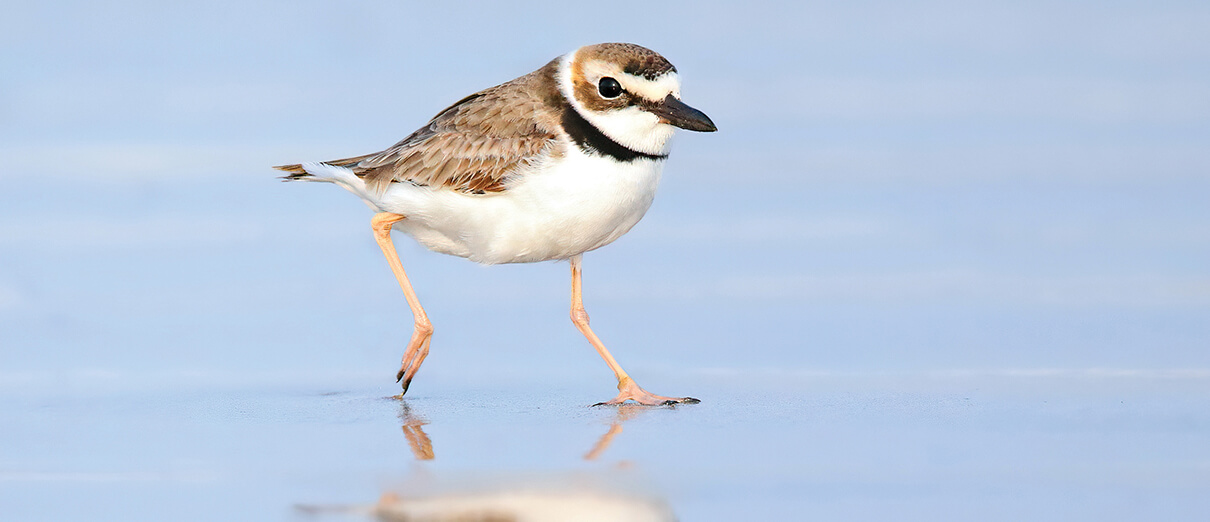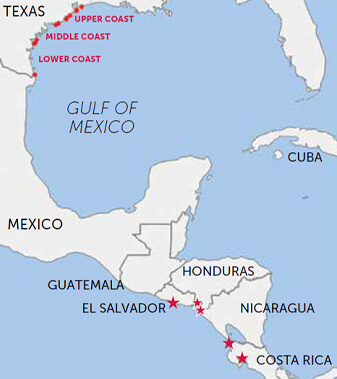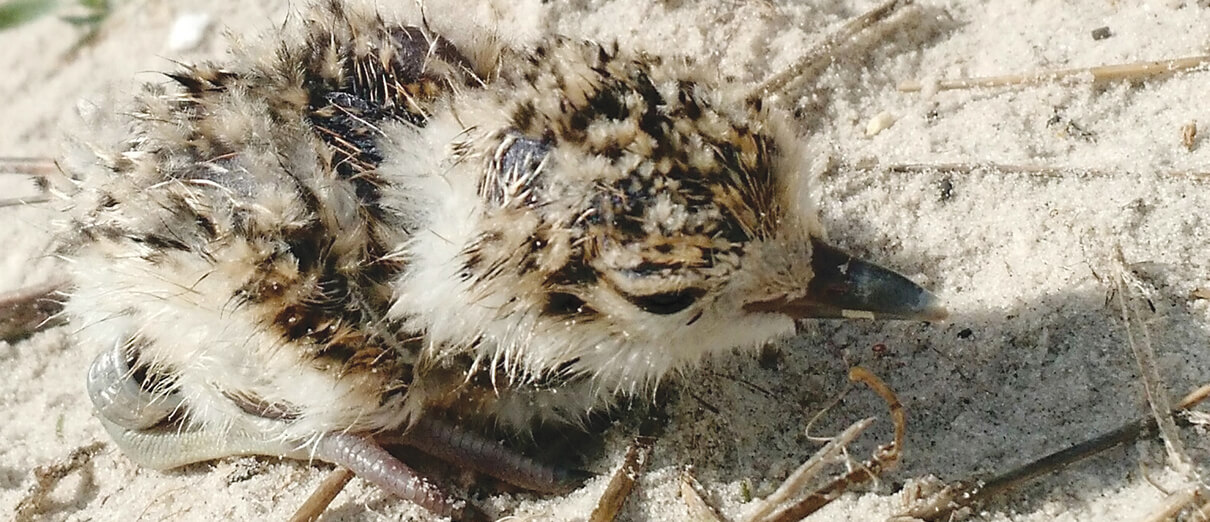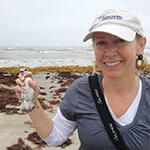Ghosts of the Coast: Protecting Beach-nesting Birds on the Gulf Coast
There is something special about watching birds in flight along the Gulf Coast in the early morning sun — listening to a Wilson's Plover's rattle as it defends its territory, or the low bark of a Black Skimmer as it flies somewhere between rays of light reflecting off the water.
These birds are as much a part of the beach as sun, sand, breeze, and surf. But many people don't even know they exist, let alone lay their eggs on the sand. And this creates problems. As ABC's Gulf Coastal Program team, we spend a lot of time watching and protecting beach-nesting birds, and educating beachgoers about the four declining species we call the “Fab Four”: the Wilson's Plover, Snowy Plover, Least Tern, and Black Skimmer.
The Gulf Coastal Program was established as a response to the Deepwater Horizon oil spill that began with an oil platform explosion in the Gulf of Mexico south of Louisiana on April 20, 2010. During this disaster, 4 million barrels of oil entered the Gulf over 87 days. Initially, our team's focus was to ensure that beach-nesting birds recovered from the spill's direct and indirect impacts, but our work quickly morphed into something more. The program evolved to address ongoing impacts of human recreational activities — human disturbance — on breeding coastal birds, as well as migratory and wintering shorebirds and seabirds.

Wilson's Plover by Tom Hopwood
Turning the Tide
Even without the dangers of human disturbance and coastal development, beach-nesting is a high-stakes gamble. High tides and storms wash away nests and chicks. Ghost crabs, coyotes, gulls, and other predators snatch nestlings and eggs. In the face of all these threats, our team works diligently with regional land and natural resource managers to protect coastal birds and the habitats upon which they depend.
Over the past ten years, we have implemented a robust conservation program with a network of partners across the Gulf states, including local, state, and federal agencies, as well as other nonprofit organizations. The goal is to implement best management practices (BMPs) that benefit the birds by reducing human impacts in sensitive nesting, resting, and foraging areas. These days, coastal Texas is where the majority of our team's conservation work occurs, while other groups cover other states.
We stay busy making sure that birds are protected in the best ways possible. Our approach is to protect habitat, educate the public and land managers, and monitor the birds' responses to the BMPs we implement, sharing this information as we work on habitat conservation plans with local and state agencies.
One of the most important actions we take is to erect signs and fencing. Depending upon the situation, these last an entire breeding or nonbreeding season, or are permanent. The goal is to indicate where well-camouflaged birds are nesting, foraging, or resting, so people can keep their distance.
We also work on an education campaign focused on the issue of trash and plastics pollution on the upper Texas coast. We will be physically removing refuse, as well as working with communities, local municipalities, and other stakeholders to prevent trash from entering coastal environments. This will have huge benefits for the birds and their habitats.

Least Terns confront a ghost crab. Photo by Jessica D. Yarnell
High Fidelity
Coastal Texas is very important to Wilson's and Snowy Plovers. An estimated 42 percent of Wilson's Plovers and 71 percent of Snowy Plovers along the Gulf of Mexico nest in Texas, according to the 2013 Conservation Plan for the Wilson's Plover, authored by Margo Zdravkovic of Conservian/Coastal Bird Conservation in 2013, and a 2012 Waterbirds journal article by Susan M. Thomas of the U.S. Fish and Wildlife Service and her colleagues.
Pre-migratory staging areas, where birds gather just prior to their southbound migration, are also crucially important. In July 2018, our team documented 286 Wilson's Plovers at the Port Aransas Nature Preserve and 136 at the Bolivar Flats Shorebird Sanctuary. That means 5 percent of the estimated U.S. population of about 8,600 individuals may have been staging at just two sites in Texas prior to migration! This has strong implications for the need to conserve Gulf Coast habitats, not only for nesting but also for staging populations of the Wilson's Plover and its cohorts.

Wilson's Plover breeding areas along the Texas Gulf Coast, and spots along Central America's Pacific coast where banded Texas birds have been re-sighted in winter.
As part of our monitoring efforts, we place a unique combination of color bands on breeding Wilson's and Snowy Plovers' legs to track individuals, estimate the number of breeding pairs, follow nest success, and document site fidelity, since plovers most often return to the same sites each year to nest. We have learned some interesting things at our monitoring sites through band re-sights, or finding the bird again after the initial banding. For instance, we see higher site fidelity from birds on the upper Texas coast than along the central and lower Texas coast (see map), with nearly all birds returning to the same breeding site each year, or nearby. Some birds even nest just a few meters away from where they did the prior year.
The nesting habitat on the upper coast has contracted and is more hemmed-in by coastal development in some areas — so the nesting sites are largely along narrow strips of Gulf-facing habitat or bayside salt flats. On the central and lower coast of Texas, however, there are more expansive salt and sand flats that are less constrained by development. These provide more nesting and foraging options for the plovers.
Going South with Wilson's Plovers
We have a wealth of knowledge about the banded birds on their breeding grounds in Texas, where we've been banding plovers for eight years. We know that nearly all Gulf Coast Wilson's Plovers migrate south of the U.S. for the winter. But exactly where do they winter, and do they stop anywhere along the way? We want to fill in these gaps in our knowledge of their annual life-cycle.
Over the past few years, we have started to receive band re-sights of Wilson's Plovers during the nonbreeding season. Almost all of those birds have turned up on the Pacific coast of Central America (see map above). We received these re-sights from biologists who conduct formal avian surveys or research, or from birders who share sightings with them. An important thing to note is that nearly all of the Wilson's Plovers re-sighted were located in active or inactive salt farms. Landscapes along the Central American Pacific coast have often been converted to salt or shrimp farms, fragmenting and degrading much of the remaining mangrove forests and mudflats. Future management of these commercial habitats is key to helping declining international travelers like the Wilson's Plover.
Déjà Vu in Central America
Through wintering season re-sights we also learned that Wilson's Plovers likely have strong site fidelity on their wintering grounds as well. One of our banded Wilson's Plovers, for example, was observed at the same salt farm in Costa Rica two years in a row. Our Gulf Coastal Program staff had the opportunity to visit this salt farm in November 2017, months after one of our Texas Wilson's Plovers had been re-sighted there. We were guided by the same person who reported the banded bird, Diego Quesada, CEO of Birding Experiences.
At the salt farm, we saw firsthand how the landscape has been converted, and how so many shorebirds use this altered habitat to rest. Multiple shallow evaporation pans, or salt pans, are separated by dikes made of dirt and rocks. All along the dikes, we observed Wilson's Plovers, perfectly camouflaged among the stones and dirt as they roosted during high tide. We didn't observe our bird, but we did re-sight a Wilson's Plover banded by our partners at Audubon Louisiana in Cameron Parish. By the end of our survey, we had counted 130 Wilson's Plovers, and likely more birds flew in to roost after we left. It was difficult to view their legs to find bands because many of the birds were sitting down. We felt lucky that we found the Louisiana coast bird, which lets us know that birds from there migrate to these areas, along with Texas plovers.

Wilson's Plover chick by Kristina Macaulay
A Trinational Plover “Convention”
Other recent surveys found large concentrations of Wilson's Plovers on the Pacific coast of Central America, underscoring the need for strategic conservation there. In January 2017, Honduran biologist John van Dort conducted a trinational shorebird count throughout the Gulf of Fonseca bordering Nicaragua, Honduras, and El Salvador. There, his team counted nearly 3,000 Wilson's Plovers, and estimated that just over 9,000 could have been present, based on available habitat, during the weekend survey.
It is likely these birds were a mix of two subspecies — Charadrius wilsonia wilsonia, which breeds on the Gulf Coast, and C. w. beldingi, which breeds on the Pacific coast south of the U.S. More information is needed to confirm this, but the large numbers raise interesting questions. In the Conservation Plan for the Wilson's Plover, the Gulf subspecies population estimate for the U.S. was approximately 8,600, meaning that van Dort's Gulf of Fonseca estimate of 9,000 exceeds the U.S. population estimate.
Furthermore, 9,000 birds also exceeds the Pacific subspecies' population estimate of 6,500 to 8,500 individuals. This points to two likely scenarios: Most likely, both subspecies mix at this wintering area; otherwise, prior estimates for each subspecies are low. Either way, the conservation implications are clear — Central America's Pacific coast holds very important migratory and wintering areas for Wilson's Plovers, and they deserve the same kinds of protection we lend during the breeding season to birds along the Texas and entire Gulf Coast.

Gulf Coast beaches are home to these denizens of sand and surf (from left to right: Black Skimmers, Wilson's Plovers, and Snowy Plovers). Artwork by Chris Vest
Tracking on the Ground and in the Air
We will continue to band birds to estimate breeding pairs, follow broods until chicks fledge, document movements and site fidelity, and get re-sights from the migratory or wintering grounds so that we can better understand and protect the birds and their key habitats. As we learn more about these beach-nesters, our posted signs, beachside conversations, and community events will help to ensure they get the space they need. Meanwhile, colleagues are filling gaps in our knowledge via technology. Our partner at Coastal Bend Bays & Estuaries Program, for example, deployed geolocators and GPS tags on Wilson's Plovers, and scientists at the Max Planck Institute for Ornithology in Germany are using similar technologies to look at dispersal and migration strategies of Snowy Plovers.
We love our work and believe these birds can survive, even thrive. But as you've read, it will take strong conviction of the public and international partners to ensure that the birds have a bright future.
ABC's Gulf Coastal Program would like to thank our core bird conservation team in Texas: Houston Audubon Society, Gulf Coast Bird Observatory, Coastal Bend Bays & Estuaries Program, the U.S. Fish and Wildlife Service's Coastal Program for Region 2, as well as other partners and supporters.
 | Kacy Ray is ABC's Gulf Coastal Program Manager. |
 | Kristen Vale is ABC's Texas Coastal Coordinator. |


















































